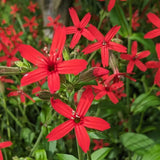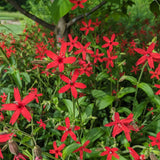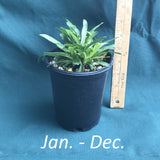Fire Pink is a stunning wildflower that dazzles with its vibrant scarlet-red blooms. Beloved by pollinators and gardeners alike, it’s a perfect addition to adding color to naturalized areas, rock gardens, or sunny borders.
- Hummingbird favorite
- Star-shaped, bright red flowers with notched petals
- Drought tolerant!
Details
- 12–18 inches in height and spreads to 12 inches wide
- Plants form a basal evergreen rosette of leaves, with upright stems bearing flowers in late spring into early summer
- Hardy in USDA hardiness zones 4, 5, 6, 7, and 8
Flowering period
Plants bloom from late spring through early summer.
How to grow
Fire Pink is easy to grow in the right conditions. They will grow in sun or shade but will have a looser habit and fewer flowers when planted in deep shade. Plants can be short-lived in rich soil and require good drainage during the summer to prevent rotting.
Care and maintenance
Plants are easy and carefree. Deadheading the old flowers will prevent self-seeding, though self-sown seedlings are nearly always welcome.
Where to plant
Fire Pink is perfect for wildflower meadows and woodland edges. Plant in clusters for maximum visual impact and to attract pollinators like hummingbirds.
When to plant
Plant Fire Pink in early spring or fall for best results.
Spacing
Between 12-18 inches apart when planting in a group.
When will my plant flower?
Plants are flowering size and will flower in late spring if purchased before April.
Native habitat and range
Fire Pink (Silene virginica) is native to the eastern and central United States. It thrives in rocky slopes, open woodlands, and dry meadows, favoring well-drained, nutrient-poor soils.
Source and origin
Plants are propagated from seeds collected off plants growing native on our property in Chatham County, NC.
| States | Orders up to $50 | Orders $51 to $100 | Orders over $100 |
| AL, DE, GA, KY, MD, NC, OH, PA, SC, TN, VA, and WV | $16 | $18 | $20 |
| AR, CT, FL, IL, IN, LA, MA, MI, MO, MS, NH, NJ, NY, RI, VT, and WI | $18 | $20 | $22 |
| IA, KS, ME, MN, OK, and TX | $20 | $22 | $24 |
| CO, NE, ND, and SD | $22 | $24 | $26 |
Sorry, we can't ship plants outside of the continental United States or to AK, AZ, CA, HI, ID, NM, NV, OR, UT, and WA due to agriculture restrictions.
When will my order be shipped?All plants are shipped within two weeks of placing an order.
Is it okay to plant in the winter?Yes, as long as the soil is not frozen. Planting native perennials in winter and early spring gives your plants a head start before the summer heat arrives.
What if it’s too cold to plant where I live, but I want to buy a plant before it sells out?Dormant plants can safely be kept in a basement, garage, or cool room until you are ready to plant in late winter or early spring.
How will my plants get delivered?Most orders are shipped on Monday or Tuesday via UPS Ground, which depending on the destination takes between 1 to 4 days.
Are your plants shipped in their containers?Yes, all our plants are shipped in their growing containers. The majority are grown in containers that are 4.5 inches wide by 5 inches deep and 32 fl. oz. / 946 ml in volume.
Do you guarantee your plants?We guarantee our plants to be healthy, ready for planting and correctly named. We are not able to guarantee whether a plant will grow in your garden as there are too many circumstances that are beyond our control.
On rare occasions, a plant shipped dormant may fail to emerge from its dormancy. If this happens, please let us know. If you are concerned about a plant, please contact us within 14 days to let us know. If we can’t help you make it grow, we’ll send you a new plant or issue a refund.
You can return your plants if you no longer want them once they arrive. To receive a refund (minus 20% restocking fee) the plants must be returned in good condition. Return shipping is the customer’s responsibility.
Can I cancel my order?Yes, you can cancel your order. Please visit our terms and service page for details.
What about sales tax?We propagate our own plants and are not required to collect North Carolina sales tax.
Where can I find information about your plants?Here are some FAQ on how we grow plants.









